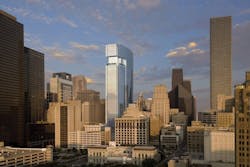Newsworthy
Disaster Tips that Every FM Should Know
In an effort to help prevent injuries, illnesses, and property damage, the Des Plaines, IL-based American Society of Safety Engineers (ASSE) offers the following safety tips that facilities managers can use after a disaster.
- Structural Security: Have the structural integrity of the facility validated by qualified professionals before anyone enters the facility.
- Safe Entry: Contact the proper government agencies to get approval to resume occupancy of the building. Do not enter unless proper clearances have been attained.
- Clean-Up Safety: Implement clean-up and business-resumption processes in a safe and healthful manner. You will accomplish nothing if your employees are injured during the post-disaster phase-in period. Provide your employees with training in selection and use of Personal Protective Equipment (PPE) such as eyewear, gloves, and dust masks/respirators.
- Air Quality Assessment: Make sure the atmosphere in the workplace environment is tested for asbestos and other chemical/toxic agents.
- Ventilation: Have vents checked to assure that water heaters and gas furnaces are clear and operable. Safely start HVAC systems and blow cold air through first to prevent the growth of mold in duct systems.
- Interior/Exterior Exposures: For interior spaces, ensure that no wall or ceiling materials are in danger of falling. Check for cracked windows and outside building materials, as these could fall on pedestrians at any time.
- Protection Equipment: It is important to confirm that fire and smoke alarms have been cleaned and tested before allowing occupancy of the building.
- Electrical Safety: Have checks made of electrical systems, computer cables, and telecommunications equipment to ensure that they are still safe and there is no danger of exposure to electricity. Wiring inspections should be conducted from the outside in to verify that wiring and connections are not in danger of shorting out due to water damage from rain or firefighting efforts.
- Use Existing Federal Guidelines: Utilize existing start-up guidance materials provided by government agencies (www.fema.gov or www.cdc.gov/niosh).
- Health/Sanitation Issues: General facility sanitation systems should be inspected and tested to guard against potential employee exposure to toxic agents. Any unused foodstuffs should be discarded.
- Office Furniture: Inspect the furniture to ensure that it can withstand expected loads and usages. Check to see that wall and panel systems have not become unstable.
- Lighting: Make sure there are adequate illumination levels. Emergency lighting should be checked to ensure that it operates and functions correctly.
- Emergency Planning: Make sure there is a clear path of egress for emergency evacuation and that fire extinguishers are still operable.
- Solid/Hazardous Waste Removal: Broken glass, debris, or other materials with cutting edges should be safely gathered and disposed of immediately.
- Power Checks: If there is no access to electricity on-site, do not use fueled generators or heaters indoors. Check for gas and sewer leaks in your facility, and contact your local utilities for information regarding power, gas, water, and sewer usage.
- Check Mainframes: If your facility has mainframe computer applications, see that lines and cabling for chiller systems are checked to avoid chemical leaks.
- Emergency Procedures: Create a new emergency plan and distribute it to employees as soon as they return to work.
Although there is no one-size-fits-all program, the tips listed above may help. For more information, go to (www.asse.org).
Hines Announces Plans for Office Tower in Houston
Houston-based Hines has announced plans to develop MainPlace, a 46-story, 1 million-square-foot office tower in downtown Houston at 811 Main Street that will be filled with tenants by late 2010. The project will be a classic urban infill development, replacing one of downtown's most blighted blocks with a signature high-rise office building that will spur redevelopment and redefine the epicenter of downtown Houston.
MainPlace tenants will be located within 4 blocks of every major downtown attraction. The building will continue Hines' ongoing commitment to the environment and leadership in green building design by being pre-certified at the Silver level by the Washington, D.C.-based U.S. Green Building Council.
"Designing and building structures that are more efficient and self-sustaining makes good business sense and will help the sustainability of our environment," says Houston Mayor Bill White. "It's good to see Hines, with its strong Houston roots, setting the pace by building the first LEED Silver skyscraper in our downtown district." Jon Pickard of Houston's Pickard Chilton, the building's architect, adds, "Our design for MainPlace acknowledges the contemporary tradition of the Houston skyscraper while keeping with the historical tradition of Main Street's classic architecture."
ASHRAE Publishes Energy Performance Comparison Standard
A common basis for reporting building energy use and comparison of energy performance is available in a new standard from the Atlanta-based American Society of Heating, Refrigerating and Air-Conditioning Engineers (ASHRAE). ANSI/ASHRAE Standard 105-2007, Standard Methods of Measuring, Expressing, and Comparing Building Energy Performance, provides a method of energy-performance comparison that can be used for any building, proposed or existing, and allows different methods of energy analysis to be compared.
This standard will help facilitate comparison, design and operation improvements, and development of energy-performance standards. The biggest change to the standard, last published in 1999, is inclusion of building energy-performance comparison, which is vital for energy-efficiency efforts worldwide. More information can be found at (www.ashrae.org).
Nation's First Green Hospital is Still Performing
The first and only Gold LEED-certified medical center in the United States celebrated its 1-year anniversary this summer. Located in Portland, OR, the Providence Newberg Medical Center set the stage for green hospital construction in 2006, when engineers and architects met Oregon's stringent structural standards for hospitals while incorporating environmental building materials and achieving environmental design.
Providence Newberg Medical Center needed special structural engineering to meet design requirements like earthquake resistance, vibration-tolerance standards, and LEED certification. Providence Health Systems spent $70.6 million to build the center as a new design, replacing the Providence Newberg Hospital. "A year later," says spokesman Mike Antrim of Providence Newberg Medical Center, "we are proud that the hospital is meeting all of our performance objectives. We are very happy with the results."
DOE to Fund Energy Audits for Schools in New Orleans
The U.S. Department of Energy's (DOE) EnergySmart Schools Program committed in August to providing $1.5 million in technical assistance for up to 75 comprehensive energy audits in public schools in the New Orleans area. The audits will include analysis of heating and cooling systems, lighting, and structural elements (such as roofing and building envelopes).
The DOE will recommend energy-efficient retrofits and upgrades for existing buildings that provide a return on investment in 3 to 5 years. The audits could identify up to $1 million in annual utility savings for New Orleans' public schools. New buildings will be designed to be 30-percent more efficient than current building codes and will be constructed and operated on a cost-neutral basis, with energy savings offsetting upfront costs.



